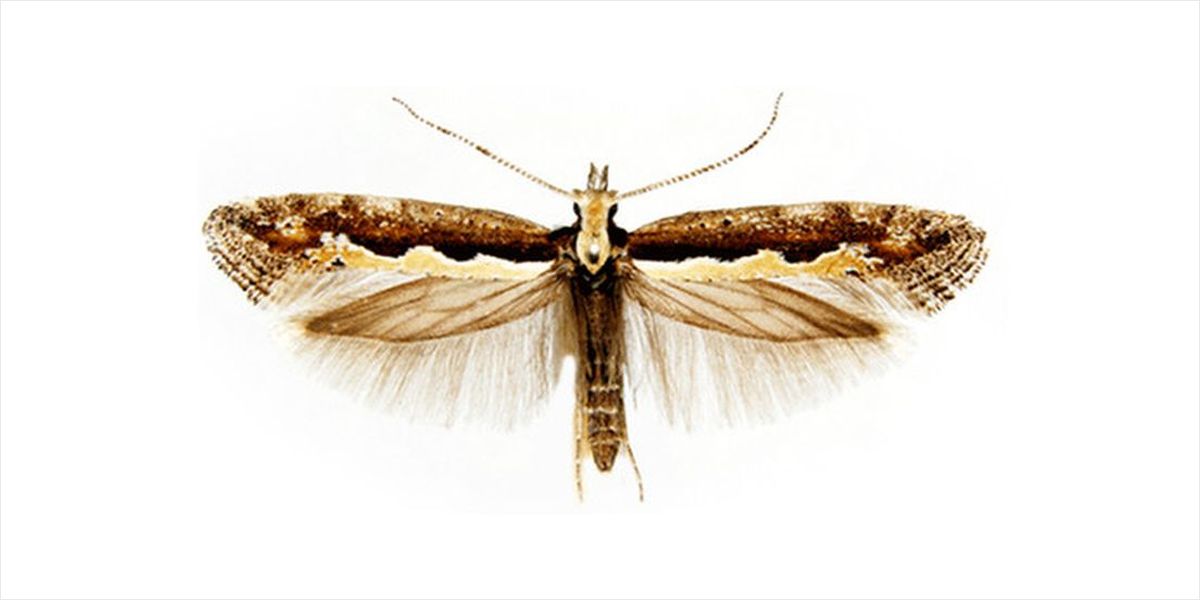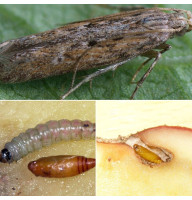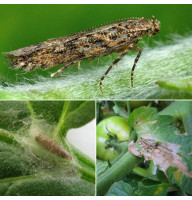Traps for catching garden pests can be viewed here.

The diamondback moth - is a dangerous pest of cabbage and other cruciferous vegetables (turnips, rapeseed, mustard, radishes, rutabaga). Development is complete. Reproduction is bisexual. Pupae and, in the south, butterflies overwinter. In the tropics and subtropics it develops throughout the year. The number of generations ranges from one (in the north of the habitat) to ten (in the southern part of the range). At the same time, the development of different generations is observed.
Morphology
Imago
A butterfly with a wingspan of 11-16 mm. The color of the wings varies from gray-brown to dark brown. A wavy yellow or white stripe runs along the rear edge of the front wings. In a calm state, the antennae are
extended forward.

Sexual dimorphism
Individuals of different sexes differ in the structure of their genital organs.
Females. The color of the wings is lighter.
Males. The color of the wings is darker.
Egg
The egg is oval, slightly flattened, length - 0.4-0.5 mm, width - 0.2-0.3 mm. Color varies from pale green to lemon yellow, with small dots on the surface.
Larva
The first instar larva (caterpillar) is practically devoid of pigmentation, but has a dark brown head. In the following centuries, the color varies from green to dark brown. There are clearly defined dark brown spots on the head. The length of the last instar caterpillar can reach 7-11 mm.
Pupa
The pupa is located in a spindle-shaped, silvery-white cocoon, usually firmly attached to the substrate. Cocoon length is 8 mm, width is 2-2.6 mm. The length of the pupa is 7 mm. At first it is pale green in color and darkens as it develops.
Development
Imago
Butterflies are active at dusk and at night, feeding on flowers of the cruciferous family. When mass development of moths occurs, flies can be observed during the daytime. Butterflies are attracted to light. The lifespan of males is up to 20 days, females - up to 30 days.
The adult emerges from the pupa in the spring of the following year or during the growing season of the current year. The moth begins feeding and reproducing almost immediately after rebirth.

Mating period
Copulation takes place on cruciferous flowers intermittently, up to six times. Males can mate up to 30 times. Egg laying begins the next day after mating and lasts 10-12 days. Eggs are laid one at a time, sometimes 2-5 at a time, on the underside of a leaf, near the main veins or on the cuttings of a host plant. Fertility - 80-90, less often 150-170, maximum up to 300 pieces.
Egg
Embryonic development lasts 4-7 days. The minimum temperature threshold is +8°C.
Larva
The larva (caterpillar) lays a light, elongated oval mine on the underside of the leaf, along the main veins. She lives in it for 3-5 days. The caterpillars then emerge from the mines and live on the surface of the leaves under the silky canopy. The first molt takes place here. At first, the caterpillars only skeletonize the leaves; later, they gnaw out rounded “windows” on the underside of the leaf, leaving the upper epidermis in them unharmed. Caterpillars from the Middle Ages usually leave the marginal leaves of cabbage and move to more tender parts of the plant. They hide in the leaf ovaries of a young head of cabbage, entwining them with silk threads containing a lot of excrement.
Each time before molting, the caterpillar weaves a silk canopy, attaches it between the large veins, hides under it, and only then molts. In total, 3-4 molts are observed, lasting 2-3 days. When developing on the ovary, the caterpillars eat the epidermis of the pods, affecting the seeds. The disturbed caterpillar quickly bends in different directions and descends along the web down to the ground. If you don't disturb her, she will climb back up the same web. The lower temperature threshold for caterpillar development is +5.4°C. 16-25 days after rebirth, the caterpillar finishes feeding.
Pupa
On the underside of the leaf, along the vein of the food plant, the caterpillar weaves a platform—the base—and builds a loose spindle-shaped cocoon on it. Cocoon length is 7-10 mm, width is 2.5 mm. In the cocoon, after 2-3 days the caterpillar turns into a pupa. The duration of development of the pupal stage is on average 7-15 days. The pupa is able to survive very low temperatures. The lower temperature threshold for development is +9°C. In the northern part of its range, the diamondback moth overwinters at the pupal stage.

Abiotic factors
The number of generations depends on the area of location. In Ukraine - up to four generations per year. The development periods of different generations partially overlap, and all phases of moth development can be observed simultaneously. The sum of effective temperatures for the full development cycle is 390-416°C. Under favorable conditions, the development cycle lasts 35-40 days.
Diamondback moth - is a dangerous pest of cruciferous crops, especially all varieties of cabbage, as well as rapeseed, turnips, radishes, radishes, turnips, rutabaga, mustard and many other cultivated plants. Larvae (caterpillars) of different ages cause damage. Adults (butterflies) feed on flowers of this family. An outbreak of mass reproduction of cabbage moth leads to the death of young plants due to damage to the central rosettes. The harmfulness threshold for all types of cabbage is set at the leaf whorl stage and is critical when 2-5 caterpillars are detected per plant when 10% of the plants or more are infested.



